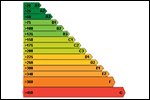Government introduces new energy rules for dwellings

Environment Minister Phil Hogan has signed the new statutory instrument for Part L of the building regulations — which deals with energy efficiency in dwellings — into law, the department has confirmed to Construct Ireland.
The new regulations aim to deliver a 60% reduction in energy performance and carbon emissions for new dwellings compared to the 2005 standards, and will become effective from 1 December 2011.
Environment Minister Phil Hogan has signed the new statutory instrument for Part L of the building regulations — which deals with energy efficiency in dwellings — into law, the department has confirmed to Construct Ireland. The new regulations aim to deliver a 60% reduction in energy performance and carbon emissions for new dwellings compared to the 2005 standards, and will become effective from 1 December 2011.
The associated technical guidance document — which provides detail on how the standards can be met — will be published by the end of June on the department's website. A public consultation relating to both the regulations and technical guidance was held last year.
The new regulations will specify minimum energy performance values for a range of building criteria — such as U-values (eg 0.21 W/m2K for walls), and airtightness (7 m3/hr/m2). But complying with these alone will not be sufficient to meet the overall regulation — dwellings must consume at least 60% less energy than the 2005 standard, which will mean some individual elements will have to perform better than the minimum standard to meet the overall requirement. Compliance is calculated using SEAI's Dwelling Energy Assessment Procedure software.
The government is aiming to introduce a "carbon neutral" standard for all new dwellings by 2013. In 2008, it updated the building regulations to demand dwellings consume 40% less energy than the 2005 standard, but the new regulations will increase that by a further 20%. The renewable energy requirement for dwellings — introduced at 10kWh/m2/yr — is expected to be retained at that level in the new technical guidance document.

